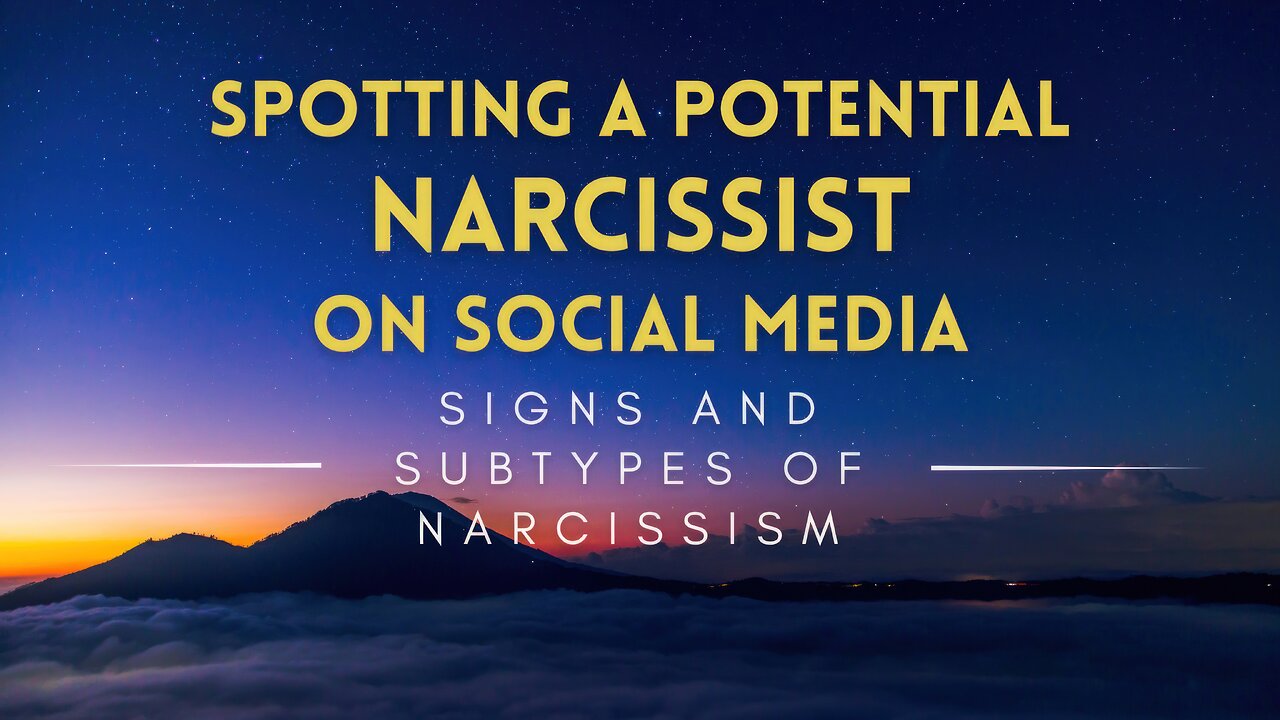Premium Only Content

56 - Spotting a Potential Narcissist on Social Media - Signs and Subtypes of Narcissism
Have you ever scrolled through your social media feed and noticed someone who just seems a bit too into themselves? Well, our latest episode uncovers the complex world of narcissism on social media, giving you the insights to spot those who march to the beat of their own self-admiration parade. We dissect the art of self-promotion, the relentless quest for likes, and the subtle difference between bragging and humble-bragging — all signs that might indicate someone's online persona is tipping into narcissistic territory. As we navigate these digital waters, we aim to arm you with the knowledge to identify and steer clear of potential toxic interactions, enhancing your understanding of the different subtypes of narcissism that are thriving in the realm of tweets, posts, and likes.
Social media has become the stage for various narcissistic performances, from the grandioise displays of self-importance to the covert cries for attention cloaked in victimhood. In this episode, we peel back the layers of narcissists' online behaviors — their exaggerations, lack of empathy, and their adverse reactions when they don't receive the adulation they feel entitled to. It's not just about calling out these traits, but about recognizing the impact they have on the broader social media environment. We dive into the characteristics of overt, covert, antagonistic, communal, and malignant narcissists, painting a vivid picture of each and their modus operandi in the digital social sphere.
Wrapping up, we tackle the sensitive topic of distinguishing between narcissistic personality disorder (NPD) and borderline personality disorder (BPD) traits in the online personas we encounter. With an emphasis on the necessity of professional diagnosis, we offer strategies for engaging with individuals exhibiting these characteristics. It's about fostering a balanced approach that respects personal boundaries while showing compassionate understanding. Tune in to navigate these tricky online relationships with a newfound perspective, and let's work together towards building healthier, more genuine online communities.
#I4L #informationforlife #narcissism #socialmediabehavior #mentalhealth #selfpromotion #narcissisticpersonality #onlinetoxicity #psychologyinsights #emotionalhealth #digitalsociology #awareness #avoidtoxicity #healthysocialmediause #onlinemindfulness #digitalawareness
American Psychiatric Association. (2013). Diagnostic and Statistical Manual of Mental Disorders, 5th Edition: DSM-5 (5th edition). American Psychiatric Publishing.
Bergman, S. M., Fearrington, M. E., Davenport, S. W., & Bergman, J. Z. (2011). Millennials, narcissism, and social networking: What narcissists do on social networking sites and why. Personality and Individual Differences, 50(5), 706–711. https://doi.org/10.1016/j.paid.2010.12.022
Besser, A., & Priel, B. (2010). Grandiose Narcissism Versus Vulnerable Narcissism in Threatening Situations: Emotional Reactions to Achievement Failure and Interpersonal Rejection. Journal of Social and Clinical Psychology, 29(8), 874–902. https://doi.org/10.1521/jscp.2010.29.8.874
Brailovskaia, J., Rohmann, E., Bierhoff, H.-W., & Margraf, J. (2020). The anxious addictive narcissist: The relationship between grandiose and vulnerable narcissism, anxiety symptoms and Facebook Addiction. PLOS ONE, 15(11), e0241632. https://doi.org/10.1371/journal.pone.0241632
Buffardi, L. E., & Campbell, W. K. (2008). Narcissism and Social Networking Web Sites. Personality and Social Psychology Bulletin, 34(10), 1303–1314. https://doi.org/10.1177/0146167208320061
Cain, N. M., Pincus, A. L., & Ansell, E. B. (2008). Narcissism at the crossroads: Phenotypic description of pathological narcissism across clinical theory, social/personality psychology, and psychiatric diagnosis. Clinical Psychology Review, 28(4), 638–656. https://doi.org/10.1016/j.cpr.2007.09.006
Caligor, E., Levy, K. N., & Yeomans, F. E. (2015). Narcissistic Personality Disorder: Diagnostic and Clinical Challenges. American Journal of Psychiatry, 172(5), 415–422. https://doi.org/10.1176/appi.ajp.2014.14060723
Campbell, W. K., & Campbell, S. M. (2009). On the Self-regulatory Dynamics Created by the Peculiar Benefits and Costs of Narcissism: A Contextual Reinforcement Model and Examination of Leadership. Self and Identity, 8(2–3), 214–232. https://doi.org/10.1080/15298860802505129
Campbell, W. K., & Foster, C. A. (2002). Narcissism and Commitment in Romantic Relationships: An Investment Model Analysis. Personality and Social Psychology Bulletin, 28(4), 484–495. https://doi.org/10.1177/0146167202287006
Carpenter, C. J. (2012). Narcissism on Facebook: Self-promotional and anti-social behavior. Personality and Individual Differences, 52(4), 482–486. https://doi.org/10.1016/j.paid.2011.11.011
Ciaramicoli, A., & Ketcham, K. (2000). The Power of Empathy: A Practical Guide to Creating Intimacy, Self-understanding, and Lasting Love in Your Life (First Printing, April 2000 edition). Dutton Adult.
Conway, C. C., Boudreaux, M., & Oltmanns, T. F. (2018). Dynamic associations between borderline personality disorder and stressful life events over five years in older adults. Personality Disorders: Theory, Research, and Treatment, 9(6), 521–529. https://doi.org/10.1037/per0000281
Gabbard, G. O., & Crisp-Han, H. (2016). The many faces of narcissism. World Psychiatry, 15(2), 115–116. https://doi.org/10.1002/wps.20323
Gebauer, J. E., Sedikides, C., Verplanken, B., & Maio, G. R. (2012). Communal narcissism. Journal of Personality and Social Psychology, 103(5), 854–878. https://doi.org/10.1037/a0029629
Gnambs, T., & Appel, M. (2018). Narcissism and Social Networking Behavior: A Meta‐Analysis. Journal of Personality, 86(2), 200–212. https://doi.org/10.1111/jopy.12305
Holtzman, N. S., Vazire, S., & Mehl, M. R. (2010). Sounds like a narcissist: Behavioral manifestations of narcissism in everyday life. Journal of Research in Personality, 44(4), 478–484. https://doi.org/10.1016/j.jrp.2010.06.001
Krizan, Z., & Herlache, A. D. (2018). The Narcissism Spectrum Model: A Synthetic View of Narcissistic Personality. Personality and Social Psychology Review, 22(1), 3–31. https://doi.org/10.1177/1088868316685018
Maxwell, K., Donnellan, M. B., Hopwood, C. J., & Ackerman, R. A. (2011). The two faces of Narcissus? An empirical comparison of the Narcissistic Personality Inventory and the Pathological Narcissism Inventory. Personality and Individual Differences, 50(5), 577–582. https://doi.org/10.1016/j.paid.2010.11.031
McCain, J. L., & Campbell, W. K. (2018). Narcissism and social media use: A meta-analytic review. Psychology of Popular Media Culture, 7(3), 308–327. https://doi.org/10.1037/ppm0000137
McGregor, J., & McGregor, T. (2013). The Empathy Trap (4/16/13 edition). Sheldon Press.
Miller, J. D., & Campbell, W. K. (2010). The case for using research on trait narcissism as a building block for understanding narcissistic personality disorder. Personality Disorders: Theory, Research, and Treatment, 1(3), 180–191. https://doi.org/10.1037/a0018229
Miller, J. D., Lynam, D. R., McCain, J. L., Few, L. R., Crego, C., Widiger, T. A., & Campbell, W. K. (2016). Thinking Structurally About Narcissism: An Examination of the Five-Factor Narcissism Inventory and Its Components. Journal of Personality Disorders, 30(1), 1–18. https://doi.org/10.1521/pedi_2015_29_177
Nowak, B., Brzóska, P., Piotrowski, J., & Żemojtel-Piotrowska, M. (2022). Narcissism and personal values: Investigation into agentic, antagonistic, communal and neurotic facets of narcissism. Personality and Individual Differences, 184, 111167. https://doi.org/10.1016/j.paid.2021.111167
Oltmanns, T. F., Friedman, J. N. W., Fiedler, E. R., & Turkheimer, E. (2004). Perceptions of people with personality disorders based on thin slices of behavior. Journal of Research in Personality, 38(3), 216–229. https://doi.org/10.1016/S0092-6566(03)00066-7
Oltmanns, T. F., & Turkheimer, E. (2006). Perceptions of Self and Others Regarding Pathological Personality Traits. In Personality and psychopathology. (pp. 71–111). The Guilford Press.
Pincus, A. L., Ansell, E. B., Pimentel, C. A., Cain, N. M., Wright, A. G. C., & Levy, K. N. (2009). Initial construction and validation of the Pathological Narcissism Inventory. Psychological Assessment, 21(3), 365–379. https://doi.org/10.1037/a0016530
Pincus, A. L., & Lukowitsky, M. R. (2010). Pathological Narcissism and Narcissistic Personality Disorder. Annual Review of Clinical Psychology, 6(1), 421–446. https://doi.org/10.1146/annurev.clinpsy.121208.131215
Raskin, R., & Terry, H. (1988). A principal-components analysis of the Narcissistic Personality Inventory and further evidence of its construct validity. Journal of Personality and Social Psychology, 54(5), 890–902. https://doi.org/10.1037/0022-3514.54.5.890
Reidy, D. E., Zeichner, A., Foster, J. D., & Martinez, M. A. (2008). Effects of narcissistic entitlement and exploitativeness on human physical aggression. Personality and Individual Differences, 44(4), 865–875. https://doi.org/10.1016/j.paid.2007.10.015
Roche, M. J., Pincus, A. L., Lukowitsky, M. R., Ménard, K. S., & Conroy, D. E. (2013). An Integrative Approach to the Assessment of Narcissism. Journal of Personality Assessment, 95(3), 237–248. https://doi.org/10.1080/00223891.2013.770400
Ronningstam, E. (2016). Pathological Narcissism and Narcissistic Personality Disorder: Recent Research and Clinical Implications. Current Behavioral Neuroscience Reports, 3(1), 34–42. https://doi.org/10.1007/s40473-016-0060-y
Rose, P. (2002). The happy and unhappy faces of narcissism. Personality and Individual Differences, 33(3), 379–391. https://doi.org/10.1016/S0191-8869(01)00162-3
Schwartz, S. H. (2012). An Overview of the Schwartz Theory of Basic Values. Online Readings in Psychology and Culture, 2(1). https://doi.org/10.9707/2307-0919.1116
Twenge, J. M., & Campbell, W. K. (2009). The narcissism epidemic: Living in the age of entitlement (1st Free Press hardcover ed). Free Press.
Weinberg, I., & Ronningstam, E. (2022). Narcissistic Personality Disorder: Progress in Understanding and Treatment. FOCUS, 20(4), 368–377. https://doi.org/10.1176/appi.focus.20220052
Zeigler‐Hill, V., Clark, C. B., & Pickard, J. D. (2008). Narcissistic Subtypes and Contingent Self‐Esteem: Do All Narcissists Base Their Self‐Esteem on the Same Domains? Journal of Personality, 76(4), 753–774. https://doi.org/10.1111/j.1467-6494.2008.00503.x
-
 LIVE
LIVE
Melonie Mac
1 hour agoGo Boom Live Ep 33!
283 watching -
 LIVE
LIVE
2 MIKES LIVE
4 hours ago2 MIKES LIVE #164 with Special Guests SARAH WESTALL and ALEC LACE!
247 watching -
 LIVE
LIVE
Sarah Westall
2 hours agoComparisons: Maui Fire and North Carolina Hurricane – Land & Resource Grabs w/ Michelle Melendez
216 watching -
 1:00
1:00
Congresswoman Harriet Hageman
5 hours agoCongresswoman Harriet Hageman Rumble Rollout
9.69K30 -
 3:13:02
3:13:02
Scammer Payback
3 hours agoCalling Scammers Live
19.7K1 -
 13:08
13:08
RealitySurvival
8 hours agoNorth American Union - Why THIS IS A BAD Idea!
1.64K8 -
 DVR
DVR
Redacted News
4 hours agoWEF is in FULL PANIC MODE over Trump, LA wildfires a failure of liberal government | Redacted News
79.5K140 -

vivafrei
8 hours agoInterview with Enrique Tarrio's Mother - Viva Frei Live
71.8K21 -
 53:07
53:07
Candace Show Podcast
3 hours agoBlake Lively VS Justin Baldoni: The Revenge of #MeToo | Candace Ep 128
64.2K75 -
 1:59:04
1:59:04
Darkhorse Podcast
6 hours agoFires, Facebook & Free Speech: The 259th Evolutionary Lens with Bret Weinstein and Heather Heying
48K21